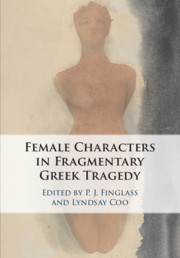Book contents
- Female Characters in Fragmentary Greek Tragedy
- Female Characters in Fragmentary Greek Tragedy
- Copyright page
- Contents
- Notes on Contributors
- Preface
- Abbreviations
- 1 Introduction
- Part I Themes
- Part II Plays
- 7 Dancing on the Plain of the Sea
- 8 Europa Revisited
- 9 When Mothers Turn Bad
- 10 The Music One Desires
- 11 Fragmented Self and Fragmented Responsibility
- 12 Female Agency in Euripides’ Hypsipyle
- 13 Making Medea Medea
- Bibliography
- General Index
- Index of main female characters discussed
7 - Dancing on the Plain of the Sea
Gender and Theatrical Space in Aeschylus’ Achilleis Trilogy
from Part II - Plays
Published online by Cambridge University Press: 11 June 2020
- Female Characters in Fragmentary Greek Tragedy
- Female Characters in Fragmentary Greek Tragedy
- Copyright page
- Contents
- Notes on Contributors
- Preface
- Abbreviations
- 1 Introduction
- Part I Themes
- Part II Plays
- 7 Dancing on the Plain of the Sea
- 8 Europa Revisited
- 9 When Mothers Turn Bad
- 10 The Music One Desires
- 11 Fragmented Self and Fragmented Responsibility
- 12 Female Agency in Euripides’ Hypsipyle
- 13 Making Medea Medea
- Bibliography
- General Index
- Index of main female characters discussed
Summary
The characterisation of theatrical space as gendered and the roles that female characters are able to play in creating, inhabiting, manipulating, and traversing that space have continued to receive sophisticated analysis. This chapter expands this discussion to encompass the relationship of non-human female characters to theatrical space, and considers how the matrix of gender and topography might have played out across the full span of a tragic production in the case of the conjectured Aeschylean trilogy of Myrmidons, Nereids and Phrygians/The Ransoming of Hector. The chapter argues that the chorus of sea-goddess Nereids provided a contrasting female presence within the trilogy, usurping the roles of the male voices central to the plays’ Iliadic source material, and demonstrates how their presence would have rendered the theatrical space unusually fluid, in both senses of the word. The suggestion is made that other Aeschylean plays with female choruses may have been similarly imaginative in their manipulation of the representation of theatrical space, often involving configurations that move beyond the oikos/polis opposition.
Keywords
- Type
- Chapter
- Information
- Female Characters in Fragmentary Greek Tragedy , pp. 105 - 124Publisher: Cambridge University PressPrint publication year: 2020
- 1
- Cited by

